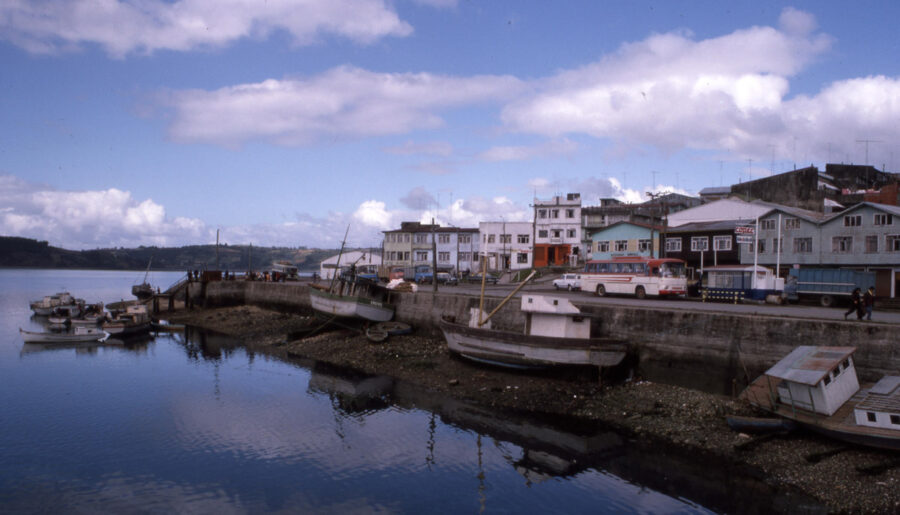Fishing from Lowestoft was transformed by an ambitious piece of 19th-century engineering. John Worrall reports
It was mainly about herring, going back as far – and further – than we can trace.
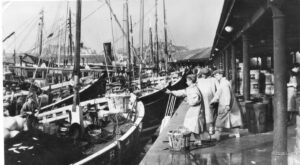
Landings at Lowestoft increased dramatically with the greater efficiency of steam. (Photo: Stanley Earl Collection)
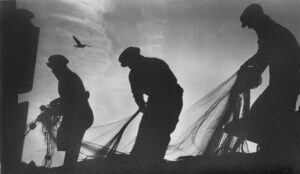
Hauling the herring. Before steam capstans appeared, farm lads finished the land harvest and then, in autumn, provided muscle power at sea. (Photo: Stanley Earl Collection)

The fleet followed the shoals south, and so did the mostly Scottish girls who cleaned the fish… (Photo: Stanley Earl Collection)
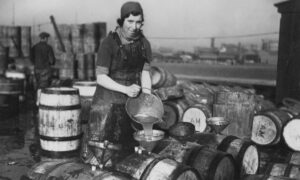
… and packed them in brine for the mainly overseas markets. (Photo: Stanley Earl Collection)
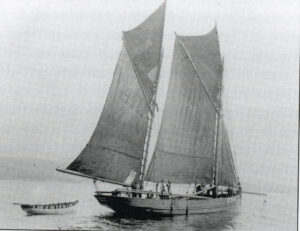
Contest LT 247, a Lowestoft sailing drifter of the type still working at the outbreak of the First World War, by which time steam was predominating.
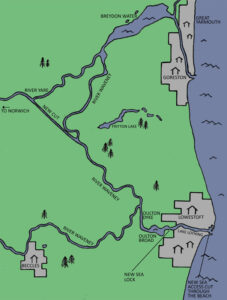
The waterways which, after 1830, gave Lowestoft a harbour.
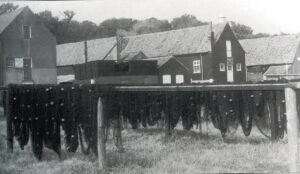
Herring nets were dried on racks on the North Denes and stored in the buildings in the background, where they would be maintained by dipping in hot cutch, an extract from the trunks of Indian acacia trees which was boiled up to a tar-like substance.
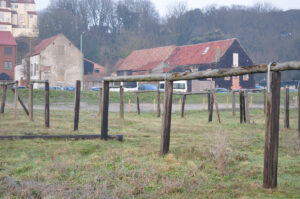
he racks are still just about there today, as more substantially are the buildings, although not a lot of cutch dipping goes on there now.
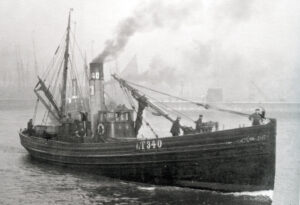
Datum LT 340 was among half a dozen drifters sunk by destroyers while attending the Dover barrage

Remembrance LT 544 saw First World War service in the Mediterranean on the Otranto barrage, and returned intact.

Enterprise II LT 408 wasn’t so lucky. She was mined off Brindisi.

A memorial to those who served in wartime stands beside Lowestoft harbour.
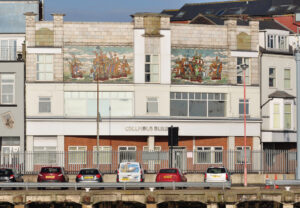
The Boston Deep Sea Fisheries group came to Lowestoft after the Second World War, eventually taking offices in the harbourside Columbus Building.
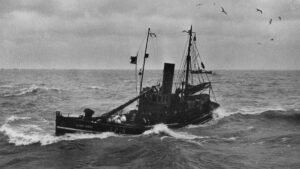
One of the Boston group’s companies owned the steam drifter Lord Hood LT 20, which won the Prunier Trophy in 1952. (Photo: Stanley Earl Collection)
From ancient times, those silver darlings featured large on all North Sea coasts, their annual shoaling bringing sustenance to Scandinavians, Britons, Dutch, French, Romans and any other countrymen who could catch them. A mention in Domesday in 1086 was an early documentation of a taste that went back much further, whether or not the benefits of omega-3 were specifically front of mind. The Vikings are even said by some to have invaded Britain because their herring had left the Baltic in our direction.
Who caught the most varied, but in the 17th and 18th centuries the North Sea was the ‘principal goldmine of the Dutch’, because by the time of James I (1603-25), they had 1,000 herring boats working off the English and Scottish coasts, and another 600-800 on cod. King James didn’t raise any objections – he’d have fitted well into this current UK government – but he did at least extract a tariff of 12 cod from every vessel.
But the Dutch pre-eminence gradually faded, more particularly after the fourth – and last – Anglo-Dutch war in the late 18th century, when the Royal Navy had become the premier maritime force in the world (which we could do with now), and in the 19th century, the UK reclaimed its waters (ditto). Domestic fleets moved south with the shoals, starting off Scotland in late summer and reaching East Anglia in autumn – and with local boats joining in, the seasonal fishery became a major feature in every port with the requisite quay space and handling facilities.
Early on, those didn’t include Lowestoft because, until well into the 19th century, it had no harbour, unlike Great Yarmouth 10 miles north, which had the haven on the river Yare. Lowestoft’s boats were all beach-launched, and its catching and handling capacity was limited.
But then, improbably, Lowestoft got a harbour, and shortly after that a railway, and that changed everything.
It came about, ironically, because of an argument between the merchants of Norwich and the Commissioners of the Haven and Piers at Yarmouth. Norwich is 15 miles inland as the crow flies, but a lot further by the meandering river Yare, which back then was still the main route for heavy goods.
Norwich, once the second-biggest city in the country, had grown rich on the medieval wool trade, and although the spinners and weavers had mostly departed for the Pennines, where harnessed streams could provide power, Norwich had moved on and was trading with the world beyond Norfolk. Its cargoes were transhipped at Yarmouth between seagoing vessels and ponderous, square-sailed keels. These could take days to make the upriver trip if winds were adverse, although by the 1800s, they were being replaced by the slightly more weatherly wherries with their fore-and-aft rig.
The trouble was that the Yarmouth commissioners had long seen transhipment as a nice little earner – disputes went back to at least 1327 – through the levying of duties, and Norwich merchants had no choice but to pay.
In 1826, having unsuccessfully petitioned parliament, those merchants cast around for another solution. They commissioned William Cubitt, a Norfolk boy and rising engineer who would go on to be big in canals and railways, to see whether ships of, say, 100t and 8ft draught could be sailed or towed straight up to Norwich and thereby avoid transhipment. And this being the go-go 19th century with all its engineering wheezes, he went with a particularly grand cunning plan to create an alternative sea access through Lowestoft.
To appreciate the logic, one has to look at the map.
Just inland of Yarmouth lies Breydon Water, a huge area of tidal mudflats which receives the rivers Yare and Waveney at its southwestern end, and narrows at its northeastern end on the edge of the town where the river Bure joins from the north – the three rivers collectively draining the Norfolk Broads. Their combined flow then reaches the sea as the continuing Yare though Yarmouth itself.
The most southerly of those rivers, the Waveney, meanders eastwards along the Norfolk/Suffolk border before turning north and passing close to the western extremity of modern-day Lowestoft near Oulton Broad, to which it is connected by Oulton Dyke, while the broad itself almost abuts the linear Lake Lothing, which at that time already stretched almost to Lowestoft beach.
The idea was to cut through to the sea, thereby creating a new route to Norwich via Lake Lothing and Oulton Broad – the two to be connected by a sea lock – and then by a widened Oulton Dyke, and sections of the rivers Waveney and Yare linked by a two-and-a-half-mile canal – the New Cut – across the marshy angle between them. Yarmouth would thus be bypassed – so it could levy what duty it liked, but Norwich wouldn’t be paying.
It was an ambitious scheme, but on 4 September, 1827, the Norwich and Lowestoft Navigation Company got to work. The harbour opened on 9 June, 1830, and the New Cut in January 1833.
But as with a lot of grand schemes, things didn’t turn out entirely as expected.
The first surprise, though it was mainly cosmetic, was that when saltwater entered Lake Lothing through the beach cut, it went in below the less dense freshwater, pushing it upwards and out to sea, whereupon not only Lake Lothing but also Lowestoft’s beaches became littered with dead pike, carp, perch, bream, roach and many other freshwater creatures. The smell lingered for a while.
More serious were the financial problems, because costs had far exceeded estimates, and some shareholders hadn’t paid up. The company had to apply to the Exchequer Bill Loan Commissioners for money to complete the New Cut. Then sea worm affected the lock timber, which was partly untreated fir, and had to be replaced by cast iron. And then mud built up and a bar formed outside.
With revenues not covering debt servicing, let alone investment, the Loan Commissioners took over but couldn’t make a go of it, and eventually, in 1844, the bankrupt project was acquired, for £12,500, by Samuel Morton Peto, already a contractor on several London landmarks, including Nelson’s Column, but by then also interested in railways.
He pumped new life into the harbour and helped sustain a light flow of shipping to Norwich – but his own cunning plan was to put a railway line alongside the New Cut and thereby connect the port to the national rail network. This he did in 1847, announcing then that fish landed in Lowestoft in the morning could reach the big conurbations the next day.
This was indeed true, although the main market for Lowestoft’s herring was for cured or salted product in Germany and Russia. But by 1872, with the port’s teething troubles themselves cured, Lowestoft’s herring fleet had grown from 80 to 210 vessels, and its population had almost trebled to nearly 14,000.
Lowestoft thus attracted the herring fleets and followers – the mostly Scottish fisher girls who gutted and packed – and provided work on a wider front, not least for the joskins, farm lads who, before steam fully reached the fleet, completed the land harvest and then worked on the boats as muscle for the hand capstans.
The first East Anglian-built steam drifter was Consolation LT 718, launched in 1897 at Lowestoft’s Chambers & Colby shipyard. She cost three times as much as a sail drifter but came with less dependency on weather and big savings on port tug charges. The following year, there were still 250 sail drifters in Lowestoft and just that one steamer, but by 1914, there were 360 steam vessels and only a handful of sail, and catches had risen dramatically.
The peak of the herring era came in 1913, when 770 boats were working from Lowestoft (and 1,000 or so from Yarmouth), a majority of them Scottish, landing 535,000 crans to the town – a cran weighing 28st.
But then, on 4 August, 1914, Britain joined the First World War, which stopped exports, filled the North Sea with mines, and initially confined fleets to port. On 15 August, Fishing News (not Dave Linkie – he hadn’t quite started) reported: “Never in the history of fishing have the East Coast ports been so congested as they are at present. Lowestoft, Yarmouth, Peterhead and Fraserborough are simply blocked with drifters that drift not, and the large ports are not a whit better.”
Many boats were commandeered by the Admiralty – but it was a Lowestoft boat, the sailing trawler Little Boys, which was still fishing the day after declaration, which struck the first maritime blow, alerting the passing Harwich Force, a flotilla of destroyers led by the cruiser HMS Amphion, that it had seen a ship throwing things overboard. The ship turned out to be the German steamer Königin Luise, an erstwhile mail and ferry boat now disguised in the shape and colours of Great Eastern Railway steamers, and laying mines.
The flotilla sank her, but then the Amphion struck two mines and was herself sunk.
Within days, at least 114 drifters and trawlers were in war service or fitting out, many of them in Lowestoft, which became the chief depot for minesweepers. Trawlers with their greater power and endurance did more of the sweeping, even if their greater draught could be a problem, while drifters tended to work on surveillance and net boom attendance, over 500 of them from Lowestoft and Yarmouth.
But a few boats kept fishing, and when the Yarmouth steam drifter City of Belfast found two mines in its herring nets near the Outer Dowsing and thus discovered the Humber minefield, it was 10 Lowestoft drifters that were sent to sweep, working in tandem pairs to get enough pull on the sweep wire. Two of them, the Lindsell and Speedy, hit mines and sank.
Drifters on submarine boom attendance were particularly vulnerable to surface attackers. In October 1916, half a dozen from Lowestoft were sunk at the Dover barrage, including the wooden drifter Datum LT 340, with the loss of 43 men – and when the accompanying old C-class destroyer HMS Flirt was picking up survivors, she too was sunk with the loss of a further 60 lives.
Many drifters went to the Mediterranean, some working the Strait of Otranto barrage where, on 15 May, 1917, surface attackers sank 14 and damaged four others – while other vessels, like Enterprise II LT 408, were sunk by mines.
After the war, the Lowestoft fleet went back to the herring, but stocks had been hammered by steam efficiency and the pre-war level of landings was never to be repeated – though not for want of trying.
In the 1930s, Paris restaurateur Madame Simone Prunier opened up in London and, by way of encouragement, offered an annual trophy to the drifter with the highest crannage in one trip. The competition ran from 1936 until 1966, the winner in 1952 being the Lord Hood LT 20, owned by the Boston Deep Sea Fisheries group, with 314¼ crans. But her ownership was a portent of things to come, because by the 1960s, herring had more or less petered out, with some drifters being converted to trawling, which was the main interest of that company.
Boston Deep Sea, established in the Lincolnshire port in 1885 (see Fishing News, 11 June, 2020, ‘Boston: Of cogs and stumps and the price of fish’), had moved to Fleetwood in the 1920s after a falling-out with the corporation, but after the Second World War, the company started fishing also from Yarmouth, and more particularly from Lowestoft, because Yarmouth was still persevering with herring.
It had offices in the harbourside Columbus Building, whose distinctive fascia mural still features the Pinta, Niña and Santa Maria and their stately rigs. Over three decades or more, the company owned around 120 boats in the two ports, 40 of them built in Lowestoft – though it didn’t buy many of them new, and constantly refreshed its fleet through selling on or scrapping.
In the 1970s, it embraced stern trawling, but its timing wasn’t the best. Although Lowestoft was never a distant-water port, the Icelandic situation following the Cod Wars hit the industry generally, not least with displacement fishing, and North Sea stocks were anyway by then suffering under the Common Fisheries Policy.
Boats were slowly sold off, a few to Canada and, in 1979, a couple, the Boston Beverley and Boston Blenheim, to southern Chile, the Beverley working from the small settlement of Chonchi on the island of Chiloé. The only thing that Chonchi had in common with Lowestoft was an east-facing coast – even more important down there in the Roaring Forties. But in 1982, the Chilean owners went broke, and both boats were last heard of in the nearby mainland port of Puerto Montt. Boston Deep Sea was wound up at about the same time.
The last deep-water company to work from the port of Lowestoft was Colne Shipping, which started there in the late 1940s, latterly working nine beamers until 2002 when, with thin North Sea plaice and sole stocks and high fuel prices, it also gave up.
And now, despite Brexit, the CFP still controls the North Sea, and with the present politics, it’s hard to envisage another Colne Shipping or Boston Deep Sea moving in for a while.

